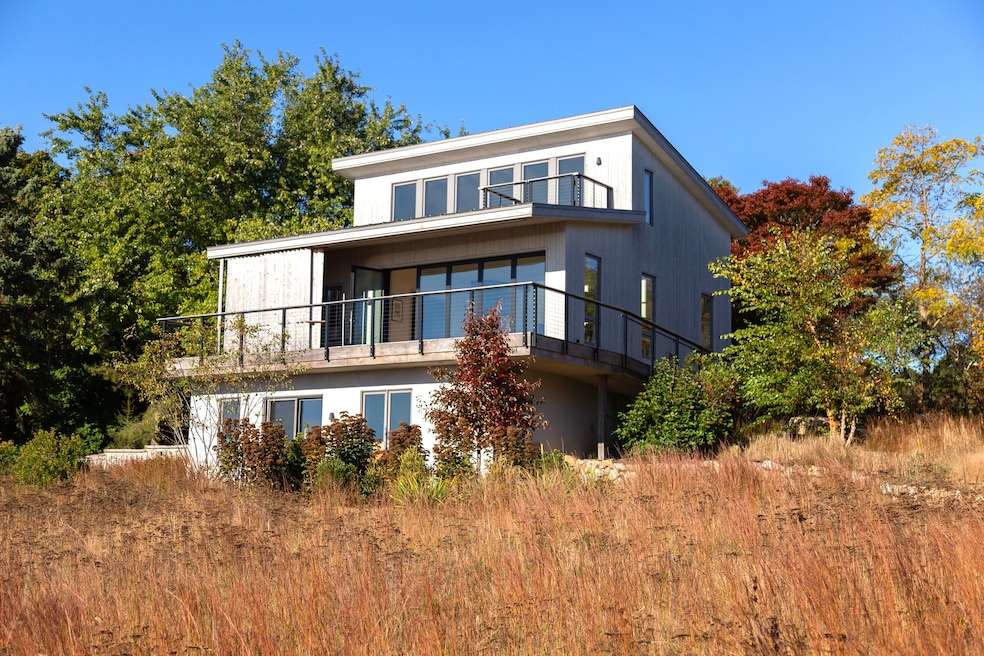Before Offshoots got involved, the Massachusetts house with views of Rockport Harbor sat on the aftershock of a construction site.
The grass was thin and yellowing in spots, and the earth itself was highly compacted from the construction process preceding the cedar-clad, single-family home now sited on the lot. But it was the land that Offshoots had to work with, armed with a clear client brief.
“He was basically looking to have the home fit into the natural landscape and have the natural landscape come up and envelop it,” said Kate Kennen, the owner and founder of the Charlestown, Massachusetts-based landscape architecture firm.
The owner of this Rockport residence — a custom homebuilder himself — also pointed toward a nearby source of inspiration: a coastal meadow filled with windswept grasses just across the street from his new property.
Little Bluestem meadow graces unsightly site
But designing a meadow on a recovering construction site took time and patience.
“We were designing a plant community that would grow in a really crappy, gravelly, compacted site,” Kennen said. Rather than amending the land into “perfect garden soils,” she said, the firm focused on creating a “successful, thriving group of plants” that suited the existing conditions.

The firm tested the soil’s classification (“meaning, Is it sandy? Is it gravelly? Is it loamy?” Kennen explained) and its horticultural components, analyzing its pH levels and available nitrogen and phosphorus.
This particular site was sandy and very lean. Typically, Kennen noted, that coarse, nutrient-light option “is not really great garden soil, which is a perfect site for a Little Bluestem meadow.”
Offshoots organized the site into areas based on the sun, moisture and existing plants, and selected Little Bluestem — a tall waving bunchgrass that can boast rusty blue tips — and other native plantings. Warm-season grasses neighbor purple lovegrass (a tufty, dry option), bayberry (a dense shrub), and lowbush blueberry (a twiggy, fruit-producing option). Selections such as tall white beardtongue and yarrow add “a couple [of] white flushes of flowers … a couple times a year.”
For larger plants, Offshoots added Eastern red cedar and gray birch, placing Amelanchier with its white flowers along the site’s wetter zones. Inkberry, a type of holly, and blueberries made up the understory, filling the shady ground beneath the trees.
Offshoots designed the scheme carefully — the meadow was rendered out and each plant individually sited long before installation began — but the project offers “a different kind of aesthetic,” Kennen said. “It’s OK for the plants to be loose and move around. This is the biggest thing we’re looking at in these landscapes, is [for] the plants to act like a community and not as individuals.”
Instead of plants isolated on mulch islands, the Rockport project knits its plants together so they can “talk to [and] rely on each other,” Kennen explained. “They support each other because they’re used to using the same microbial conditions and pH and soil conditions.”
It's not a ‘meadow-out-of-a-can’

Offshoots marries landscape architecture with horticultural expertise, focusing its practice more on “alternative ecological landscapes.” As natural as the Rockport meadow might look at a cursory glance, it’s carefully curated and maintained, and the installation process that brought it to life was detailed and patient.
“The challenge with [the meadow] is that it takes at least three years to fully establish it,” Kennen said. “This is not a meadow-out-of-a-can sort of situation.”
Instead, Offshoots began by tackling the plentiful weeds — largely nonnative, agrarian species that arrived “when we first had Colonial establishment.”
“You have to express the dormant weed seed beds,” Kennen said. Offshoots kept the land’s existing soil, but that soil had existing weeds and existing seeds from those weeds. Getting rid of those weeds required three rounds of “growing it out, killing it off.”
It takes its cues from wild landscapes

After eliminating the weeds, Offshoots seeded the meadow with the chosen plantings, keeping it closely trimmed for a year to establish the new seeds. By year two, Offshoots let it grow longer. By year three, “the meadow is much more established,” Kennen said, emphasizing how important it is to have a horticulturist establish it.
“You’re not going to be doing this on your own, unfortunately,” she noted. But that effort pays off for wider communities.
“We’re looking to re-create the grassland meadows that were here pre-Colonial times, which support a lot more of our native insects and a lot more of our native birds,” Kennen said. It’s an effort reflected in slowly evolving aesthetics throughout the United States, which balance yards that are “a little bit looser” but still cared for.
By keeping the species palette tight, maintaining consistent heights and tidying the edges, the landscape “doesn’t look so wild,” Kennen said.
“I think that’s kind of the sweet spot of these more naturalistic landscapes is that people still have to see the cues to care, to understand that they’re being maintained,” she continued. “We take some of the cues from our wild landscapes to make these landscapes less resource-intensive, less reliant on fertilizer, less reliant on showing up every day with your mower and burning CO2.”
